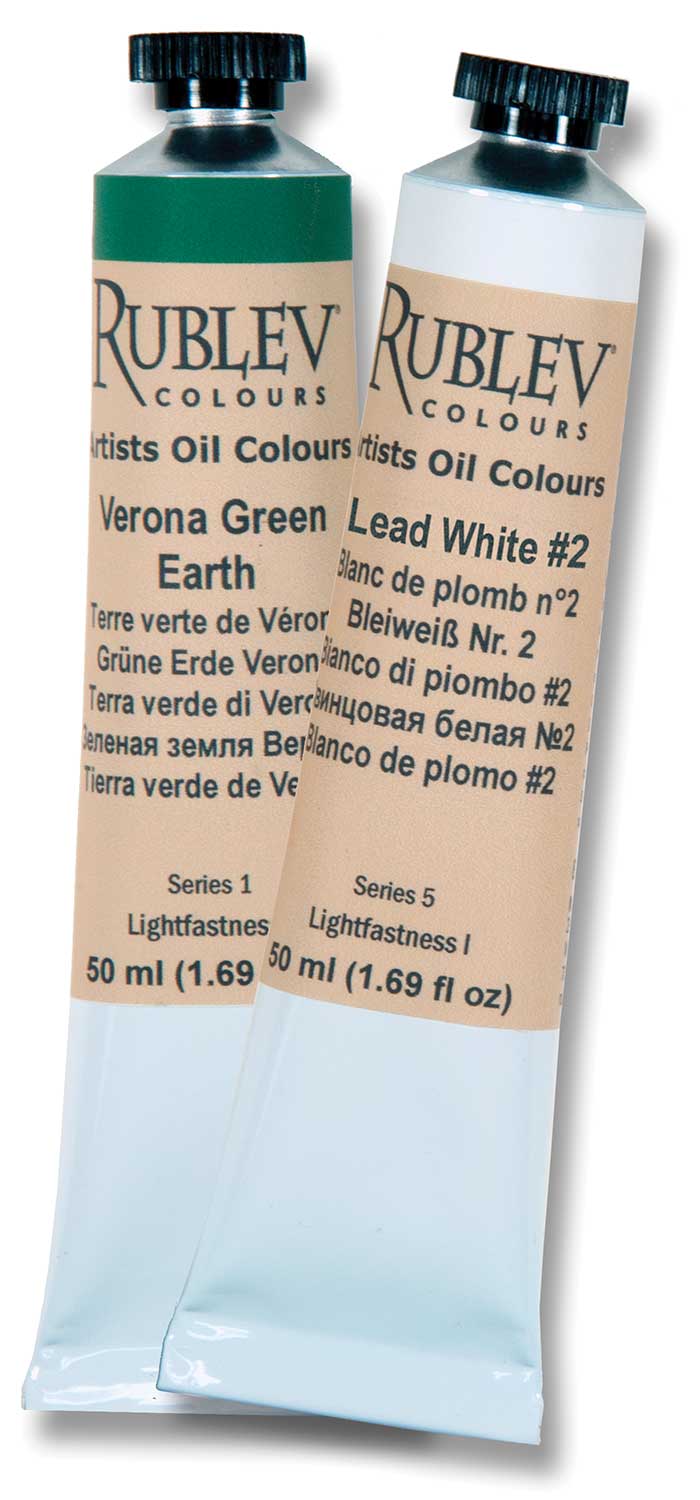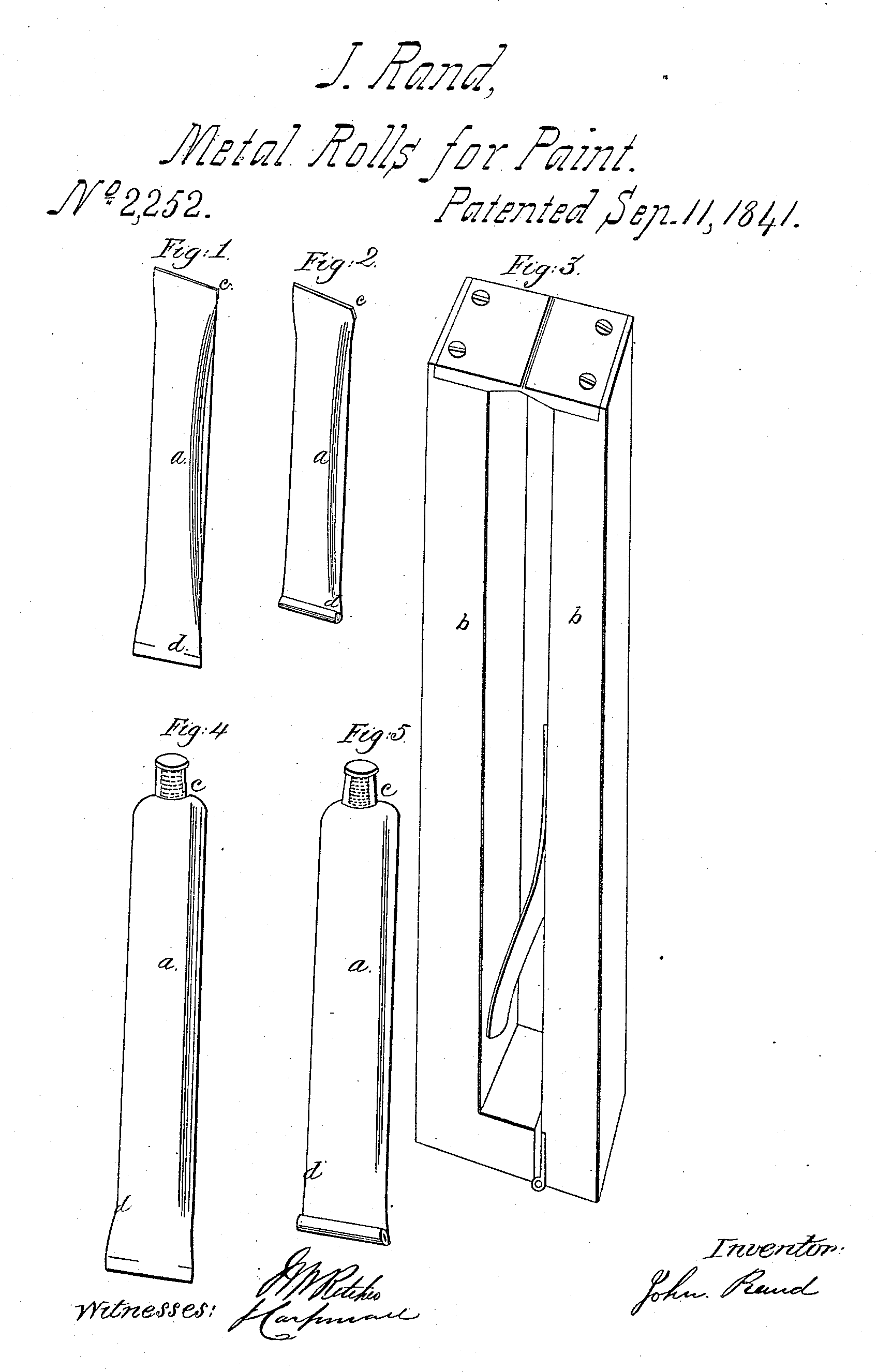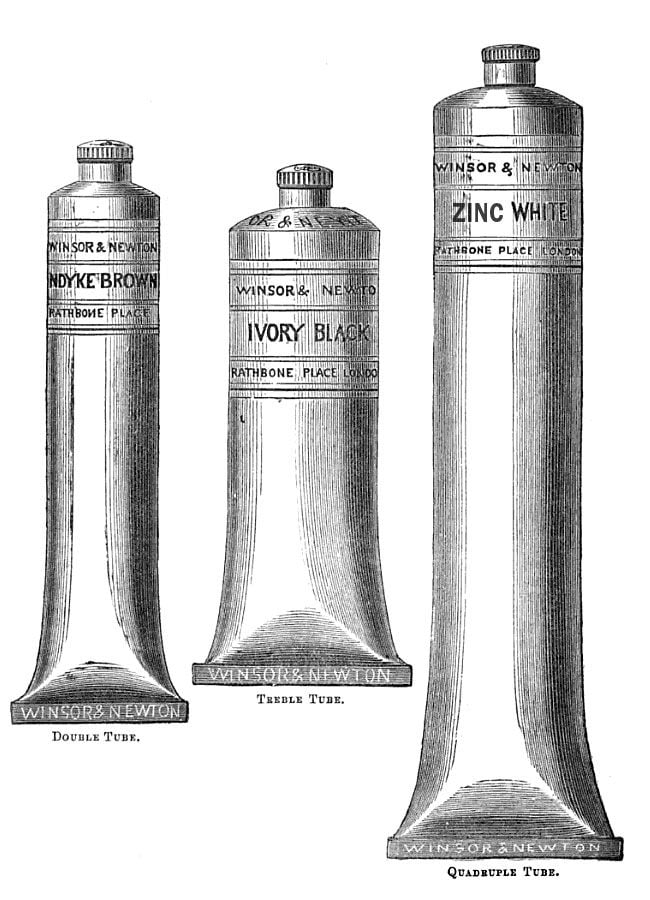 Is there anything new in artists’ oil paint?
Is there anything new in artists’ oil paint?
Can there really be anything new in artists’ oil paint? With so many different brands, how does one distinguish between them? It is pretty simple, as we’ll explain here...
Since the introduction of the collapsible tube over 170 years ago, manufactured artists’ oil paint has changed how artists work. Artists no longer must laboriously grind pigment in oil to make paint. With this change also came greater uniformity in oil paint. Let’s face it; the composition of oil color is fairly simple. Generally, only two ingredients are needed to make oil paint—pigment and oil. Soon after the introduction of commercial oil paints in the nineteenth century, a third ingredient was introduced: a stabilizer. This additive prevents the oil from separating from the pigment while stored in tubes. As more and more pigments manufactured by large industrial companies found their way into artists’ oil colors, so too the last differences between artists’ oils disappeared.
But not entirely.
Rublev Colours Artist Oils are unlike any other brand of oil paints today. Why are Rublev Colours different from other manufactured oil paints? One reason is that we use genuine natural and historical pigments like those used by the old masters. Most of these pigments are not found in other brands.
Another reason is that we make Rublev Colours Artist Oils as they did before modern tube colors—without additives. Rublev Colours Artist Oils contain only pigment and oil. They are formulated to maintain the unique characteristics of each pigment in oil. The character in each tube of our oil colors is unique due to the pigment inside, giving the artist new choices of texture, opacity, consistency, tone, and hue. With Rublev Colours, you experience the transparency of yellow ocher, the pale coolness of green earth, and the crystalline glitter of blue azurite.
A Brief History of Modern Oil Paint
Let’s see how developments in the past two centuries have changed artists’ oil paint to understand better how these differences are essential. Many of these changes have brought about greater efficiency for manufacturers, but at what cost to artists?
 Collapsible Tubes
Collapsible Tubes
While in London, the artist John Rand invented a collapsible paint tube made of tin for storing artists’ oil paints. Prior to this advancement, painters generally mixed pigments with oil in small amounts and stored the paint in animal bladders or glass syringes. The tin tube allowed unused paint to be stored and used later without drying out. The collapsible tube was initially marketed by Thomas Brown, a London-based colormen firm (Harley 1971). Rand was issued two patents, one by the British Patent Office and another by the U.S. Patent Office. The first (March 6, 1841, #8,863) was for “Improvements in preserving paints and other fluids,” the second (September 11, 1841, #2,252) was for “Improvement in the construction of vessels or apparatus for preserving paint,” (Rand 1841) and the third (September 29, 1842, #9,480) was for “Improvements in making and closing metallic collapsible vessels” (Harley 1971).
By 1842, the tube was being sold exclusively by the firm of Winsor & Newton as “Rand’s Patent Collapsible Tube” (Fairbairn 1982). By the 1850s, the Winsor & Newton Collapsible Paint Tube (note that “Rand” has been dropped) was being advertised in the trade catalogs of New York firms such as Goupil & Co. and Masury & Whiton (New York City Directory 1858) and also in Paris in the earliest of the Sennelier catalogs of 1887. (Katlan 1999)
Although some claim paint in tubes has changed how some artists approach painting, this is an overly simplistic view. They often provide the quote of the father of Pierre-Auguste Renoir as proof of this claim, “Without paint in tubes there would have been no ...Impressionism.” (Callen 2000) However, it is agreed that collapsible tubes revolutionized how artists’ paints are made and sold commercially.
Pigments
Before the nineteenth century, artists bought pigments from merchants, such as apothecaries, and sometimes ground their pigments from stones or earth. During the nineteenth century, pigment manufacturing began in earnest throughout Europe due to innovations from the Industrial Revolution and advances in chemistry. American manufacturing of artists’ pigments appears to have begun in the early nineteenth century when Cholwell & Mercein had a “manufactory” of watercolors located at 178 Front Street, New York, NY.
While many new and exciting pigments were introduced in the two centuries following the start of the Industrial Revolution, some failed to live up to the high expectations of art materials manufacturers.
Titanium White
Titanium dioxide white pigments have become one of the most essential pigment groups today and are products of twentieth-century technology. Although the incorporation of titanium white in commercial paint began in 1919, the industry remained skeptical into the 1920s of the claims made for these pigments. Some pigment supply occurred in France from the mid-1920s, but it was not until the 1930s that artists’ manuals indicated a degree of acceptance. (Laver 1997)
Out of concerns for lead poisoning, titanium dioxide white has almost entirely replaced basic lead carbonate (lead white or flake white) on the artists’ palette. But does this pigment make a good substitute for the principal white pigment on the artists’ palettes for the past 400 years? In a forum post, Jaap Boon described the role of lead white as “multiple.” A thorough drier links the acid groups of drying oil, stabilizing the paint in the early drying stages and further stabilizing it to form a strong, flexible film. Without lead white, something else must assume these roles to achieve the results we see in old master oil paintings. He concludes, “I don’t think that that magical material has been found yet simply because we have only very recently begun to understand the molecular structure of paints. It is my belief that the period 1950–2000 will bring us many defects in the oil paints that are now maturing.” (Boon 2007)
Recent concerns about the use of titanium white in artists’ paint reverberate Boon’s sentiment. A paper by Smithsonian researchers found that titanium white forms a flexible film but is not as strong as lead white paint.
 Zinc White
Zinc White
Although first produced in 1781, it was about 50 years before artists adopted zinc white. As early as 1834, according to Church, a dense form of zinc white was introduced by Winsor & Newton under the name “Chinese white.” (Church 1901) The major obstacle in the way of its use among artists was its poor drying qualities in linseed oil. In the years 1835–1844, Leclaire in France showed that this difficulty could be overcome by using zinc oxide in oil that had been made faster drying. By 1850, it was regularly made as oil paint.
A paper by Mecklenburg and Tumosa, two scientists at the Smithsonian’s Museum Conservation Institute, exposes long-term problems with zinc white in oil paint. The report “The Chemical and Mechanical Effects of Pigments on Drying Oils” describes the highlights of a 28-year study on the stability and strength of oil paint films. The results are revealing and have important implications for artwork made with artists’ oil paints containing zinc white. Several white pigments were studied, including lead white, titanium white, and zinc white. What is of interest about the paints made with zinc white and drying oils is that they become extremely brittle in as little as three years. The report shows that a 14.5-year-old paint snaps like glass when bent. It compares a 14-year-old paint made with lead white and linseed oil, which can elongate 4.5% before breaking, to zinc white paint of the same age, which can only elongate 0.3%. (Mecklenburg 2007)
Today, zinc oxide is routinely added to manufactured artists’ paints labeled titanium white, flake white, and many pale colors called hues. The paper states, “These paints often become very brittle in as little as three years if excessive zinc is used.” (Mecklenburg 2005)
Modern Additives
As commercial oil paints replaced those hand-ground by artists, manufacturers sought ways to prevent oil and pigment from separating in the tubes as the paints sat on store shelves or in artists’ paint boxes. Aluminum stearate, a metallic soap, was particularly effective in mitigating this tendency for pigment and oil to separate. When aluminum stearate was first introduced to artists’ paints is not known, but it is directly mentioned in a 1942 painting materials review (Gettens and Stout 1942) and in a paper by Levison in 1949 when he wrote “...the use of aluminum stearate, customary for several decades, was openly declared...” (Levison 1949)
In addition to aluminum stearate, several other stearates, such as magnesium, were introduced into many commercial oil paint brands later in the century. Stearates alter the consistency of oil, ultimately changing the way the paint handles. With increasing amounts of stearates, the oil pigment mixture becomes viscous, and by using an appropriate amount of stearate, the paint can gel at a lower pigment concentration (Mayer 1965). This can be used to create a “cheaper” paint since a smaller amount of costly pigment needs to be used. (Tumosa 2001)
Rublev Colours Makes It Simple Again
By making oil paint simple again, Natural Pigments gives artists new choices. Rublev Colours Artist Oils provide a new selection of colors by restoring natural and historical pigments to the artists’ palette. Without modern additives, these paints have a decidedly different consistency and feel under the brush. This is an important distinction for artists who have only known modern oil paints.
Rublev Colours are different from other commercial oil colors. One reason is we use natural and historical pigments like those used by the old masters. Another is we make them as they did before modern oil colors—without additives.
Rublev Colours Artist Oils are formulated to maintain the unique characteristics of each pigment in oil. What you find in each tube is unique due to the pigment inside, giving you new choices of texture, opacity, consistency, tone, and hue. With Rublev Colours, you experience the transparency of yellow ocher, the pale coolness of green earth, and the crystalline glitter of blue azurite.
Color Particle by Particle
The particles of natural pigments are larger and more varied than pigments in modern artists’ oil colors. When we remember how crystalline pigments, such as azurite, malachite, and lazurite, were used in old masters’ paintings, it is easy to understand how these beautiful surfaces with broken lights were obtained. An examination, for instance, of azurite particles under the microscope at once reveals the beautiful mass of blue and blue-green crystals, reflecting light in all directions and thus, of course, enhancing the visual effect.
No Additives
Rublev Colours Artist Oils do not contain additives, such as fillers, driers, and stabilizers—simply pigment and oil. We use linseed oil in our paint, sometimes with a small amount of heat-bodied linseed oil. Stabilizers, such as stearates and waxes that diminish the individual effects of pigments are not added. Due to individual pigment characteristics, you will find different consistencies from color to color. Some colors brush out long, others short and buttery, and others are thixotropic.
Overall, Rublev Colours Artist Oils have longer brushing consistency than most tube colors today, making them ideal for both bristle and soft hair brushes in fine rendering on both fine-weave canvas and smooth panels.
Single Pigment Colors
When you see a color name on our label, you get just that—one pure pigment. For example, Rublev Colours Vermilion is not a hue but the genuine pigment—pure red mercuric sulfide. In a tube of Rublev Colours Green Earth, you will not find a mixture of pigments but the real thing—green earth. And Rublev Colours Naples Yellow is pure lead antimonate. You won’t even find the word “genuine” used to describe Rublev Colours because all colors are simply that—genuine. All our earth colors have outstanding lightfastness; most others are permanent when used at full strength. Rublev Colours Artist Oils offer an extraordinary range of tinting strength and an immense diversity between opacity and transparency.
Where to Buy
See the entire color range of
References
Boon, Jaap (2007) “Lead White,” AMIEN, August 30, 2007. (AMIEN website is no longer active since 2014.)
Callen, Anthea (2000) The Art of Impressionism: How Impressionism Changed the Art World. Yale University Press, p. 106.
Church, Arthur H. (1901) The Chemistry of Paints and Painting. 3rd ed. London: Seely, Service, and Company. p. 134.
Fairbairn, Lynda (1982) Paint and Painting: An Exhibition and Working Studio Sponsored by Winsor & Newton to Celebrate their 150th Anniversary. London: Tate Gallery. pp. 68–69.
Gettens, Robert J., and Stout, George L. (1942) Painting Materials, D. Van Nostrand Company, Inc., p. 93.
Harley, Rosalind D. (1971) “Oil Colour Containers: Development Work by Artists and Colourmen in the Nineteenth Century.” Annals of Science 27:1–12.
Katlan, Alexander (1999) “The American Artist’s Tools and Materials for On-Site Oil Sketching”, Journal of the American Institute for Conservation (JAIC) 1999, Vol. 38 No. 1, pp. 21–32.
New York City Directory for 1858–1859. 1858. New York: Trow’s Directory Co.
Laver, Marilyn (1997) “Titanium Dioxide Whites,” Artists’ Pigments. A Handbook of their History and Characteristics, Vol. 3, FitzHigh, Elizabeth West (ed.) Oxford University Press, pp. 295–355.
Levison, Henry W. (1948) “The Effect of Aluminum Stearate on Embrittlement of Highly Pigmented Oil Films,” Official Digest of the Federation of Paint and Varnish Production Clubs, Nov., p. 826.
Mayer, Ralph, (1965) The Artist's Handbook of Materials and Techniques, Revised Edition, The Viking Press, pp. 150–153.
Mecklenburg, Marion F.; Charles S. Tumosa and David Erhardt (2005) “The Changing Mechanical Properties of Aging Oil Paints,” Material Research Society Symposium Proceedings, Vol. 852, Materials Research Society, pp. 4–5.
Mecklenburg, Marion F. and Charles S. Tumosa (2007). “The Chemical and Mechanical Effects of Pigments on Drying Oils.” Unpublished. pp. 13–14.
Rand, John (1841) “Improvement in the Construction of Vessels or Apparatus for Preserving Paint,” U.S. Patent 2,252, issued September 11, 1841.
Tumosa, Charles S. (2001) “A Brief History of Aluminum Stearate as a Component of Paint,” WAAC Newsletter 23(3) pp. 10–11.


 Is there anything new in artists’ oil paint?
Is there anything new in artists’ oil paint? Collapsible Tubes
Collapsible Tubes Zinc White
Zinc White